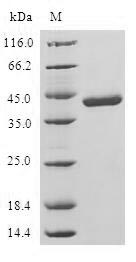This Human NME4 recombinant protein was produced in E.coli, where the gene sequence encoding Human NME4 (1-187aa) was expressed with the N-terminal GST tag. The purity of this NME4 protein was greater than 90% by SDS-PAGE.
NME4 is an enzyme located within the mitochondria, and it is associated with nucleotide metabolism and cellular energy production. Specifically, NME4 catalyzes the reaction of nucleotide diphosphorylation, converting a nucleotide monophosphate into a nucleotide diphosphate. This is an important biochemical process that occurs within mitochondria and is closely related to the generation of adenosine triphosphate (ATP). The primary biological role of NME4 is to maintain the production of ATP within the mitochondria. ATP is the primary energy molecule inside cells, and it plays a crucial role in various biological processes, including muscle contraction, cell signal transduction, and cell division. Therefore, NME4 is essential for maintaining normal cellular functions and survival by ensuring an adequate supply of ATP.






